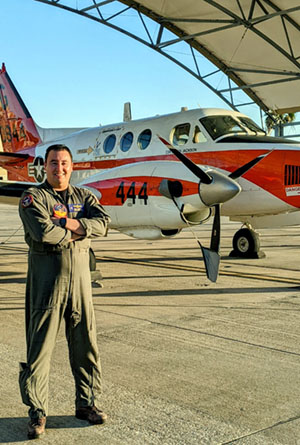
A Huntington Beach, California, native is serving in the U.S. Navy where naval aviators learn the skills they need to fly missions around the world.
Lt. Michael Stengel, a 2010 graduate of Edison High School and 2014 University of Arizona graduate, joined the Navy eight years ago.
“I joined the Navy to see the world and to see different countries,” said Stengel. “Ultimately, I wanted to fly planes and the Navy offered that opportunity.”
Skills and values learned in the Navy are similar to those found in Huntington Beach.
“I was raised to stay humble,” said Stengel. “I learned if you work hard and put the time in, no dreams are out of reach.”
Stengel serves as an instructor pilot with Training Squadron 31, an advanced multi-engine training squadron, located at Naval Air Station Corpus Christi, Texas.
“I get to fly planes, so I’m living my dream every day,” said Stengel.
The air training program focuses on the increased complexity of today’s aircraft. After successfully completing the rigorous program, naval aviators earn their coveted “Wings of Gold.”
After graduation, pilots continue their training to learn how to fly a specific aircraft, such as the Navy’s F/A-18 Super Hornet fighter attack jet, the F-35 Lightning strike fighter jet or the SH-60 Seahawk helicopter. These aircraft take off from and land on Navy aircraft carriers at sea.
Navy aircraft carriers are designed for a 50-year service life. When the air wing is embarked, the ship carries more than 70 attack fighter jets, helicopters and other aircraft, all of which take off from and land aboard the carrier at sea. With more than 5,000 sailors serving aboard, the aircraft carrier is a self-contained mobile airport.
Aircraft carriers are often the first response to a global crisis because of their ability to operate freely in international waters anywhere on the world’s oceans.
Since USS Langley’s commissioning 100 years ago, the nation’s aircraft carriers and embarked carrier air wings have projected power, sustained sea control, bolstered deterrence, provided humanitarian assistance and disaster relief, and maintained enduring commitments worldwide.
“The aircraft carrier is our U.S. Navy’s centerpiece, our flagship, and a constant reminder to the rest of the world of our enduring maritime presence and influence,” said Rear Adm. James P. Downey, USN, Program Executive Officer (PEO) Aircraft Carriers. “These ships touch every part of our Navy’s mission to project power, ensure sea control, and deter our adversaries.”
With more than 90 percent of all trade traveling by sea, and 95 percent of the world’s international phone and internet traffic carried through fiber optic cables lying on the ocean floor, Navy officials continue to emphasize that the prosperity and security of the United States is directly linked to ready sailors and a strong Navy.
“Maintaining the world’s best Navy is an investment in the security and prosperity of the United States, as well as the stability of our world,” said Adm. Mike Gilday, Chief of Naval Operations. “The U.S. Navy—forward deployed and integrated with all elements of national power—deters conflict, strengthens our alliances and partnerships, and guarantees free and open access to the world’s oceans. As the United States responds to the security environment through integrated deterrence, our Navy must continue to deploy forward and campaign with a ready, capable, combat-credible fleet.”
Serving in the Navy means Stengel is part of a team that is taking on new importance in America’s focus on rebuilding military readiness, strengthening alliances and reforming business practices in support of the National Defense Strategy.
“We protect the freedom of the seas and the nation as a whole,” said Stengel.
Stengel has many opportunities to achieve accomplishments during military service.
“I’m most proud of being an instructor pilot and being able to teach others my passion because it’s a very rewarding experience,” said Stengel.
As Stengel and other sailors continue to perform missions, they take pride in serving their country in the United States Navy.
“It’s an honor and a privilege to wear this uniform and represent my country,” said Stengel. “I am making my family proud and hopefully, setting an example for others.”
Stengel is grateful to loved ones back home for helping make a Navy career possible.
“I would like to thank my wife, Rachel, and my parents for supporting my decision to serve my country,” added Stengel.
